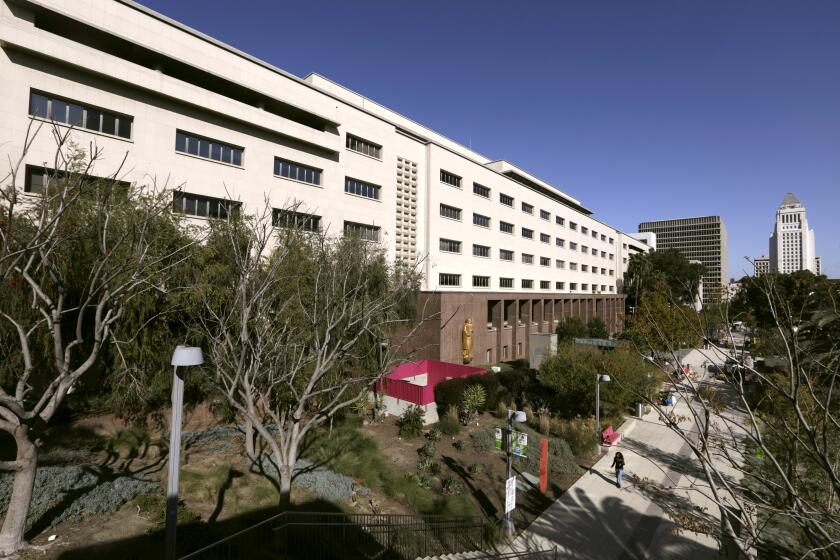Fed’s Beige Book Says Wages Are in Check
- Share via
WASHINGTON — The results of the recent surveys of national economic conditions by the Federal Reserve Board’s 12 regional banks are beginning to sound like a stuck record: moderate economic growth, rising retail sales, tight labor markets, scattered reports of upward pressure on wages but relatively flat retail prices.
That was the picture painted once again Wednesday when the Fed released the findings of the survey conducted last month for use by central bank officials at their next policymaking session May 20.
In Wednesday’s edition of the Fed’s Beige Book--which carries the national survey results and is named for the color of its cover--there were several comments that indicate that wages aren’t taking off.
“Despite continuing reports of labor shortages, wage pressures, as well as prices, are said generally to be in check,” said the Atlanta Federal Reserve Bank of its Southeastern district. “Although some contacts report higher input prices, they also mention an inability to pass increases on to the end user, reflecting in large part competitive pressures from both domestic and foreign markets.”
Likewise, the San Francisco Federal Reserve Bank district, which covers most Western states, reported that growth had picked up in most areas except Alaska and Hawaii. Led by aerospace and high-tech industries, manufacturing in the region remained strong, but labor shortages were evident. It also said commercial and residential construction was on the rise.
The Fed also reported that borrowing by U.S. consumers increased at a slower-than-expected pace in March, a sign lenders have tightened their purse strings over concerns about high levels of household debt.
Borrowing increased $2 billion for the month to $1.212 trillion, after rising an unrevised $6.7 billion in February. Analysts had expected an increase of $6.8 billion in March.
The Beige Book results, while similar to those of January and March, provided little new guidance for the policymakers who must decide whether to raise short-term interest rates again. They raised rates by a quarter-percentage point in March to guard against too rapid growth later this year, which could spark a rise in inflation.
Fed officials generally expect growth to slow from its torrid 5.6% pace of the first three months of this year. Fed Vice Chairman Alice B. Rivlin said again Wednesday that she does.
The questions before them are: How soon will the slowing be clearly evident? Will inflationary wage pressures emerge before that happens? And do rates need to be raised again to help ensure that the slowing occurs? Many analysts now expect the Fed to lift them by another quarter point two weeks from now.
Meanwhile, the Labor Department issued a report Wednesday indicating that employers’ costs per hour of pay and benefits for their workers rose at a sharp 4.7% annual rate in the first three months of this year, but that productivity gains offset nearly half the increase. That suggested to some analysts that rising wages haven’t been putting upward pressure on prices, so far.
In the nonfarm business part of the economy, output of goods and services rose at a 6.8% rate in the first quarter, while the number of hours worked went up 4.7%. That meant that productivity--output per hour worked--increased at a 2% rate. (The numbers do not add up exactly due to rounding.)
Subtracting the rise in productivity from the rise in compensation left unit labor costs, a key determinant of inflation, increasing at a 2.7% rate for the quarter. That increase was up slightly from the final three months of last year, but less than the 2.9% rise in unit labor costs recorded for both 1995 and 1996, the department said.
The report was enough to send U.S. financial markets off. After two sessions of record highs, the Dow Jones industrial average retreated 140 points to finish at 7.085.65, while bond yields rose close to 7%.
Nationally, a surge in consumer spending was responsible for much of the first quarter’s strong economic growth, and the Beige Book found that while “retail sales were above year-ago levels,” new-car and light-truck sales “tapered off from very high March levels [last month],” the survey summary said.
(BEGIN TEXT OF INFOBOX / INFOGRAPHIC)
Business Productivity
Percentage change from previous quarter at annual rate, seasonally adjusted:
First quarter 1997: 2%
Source: Labor Department
More to Read
Inside the business of entertainment
The Wide Shot brings you news, analysis and insights on everything from streaming wars to production — and what it all means for the future.
You may occasionally receive promotional content from the Los Angeles Times.










